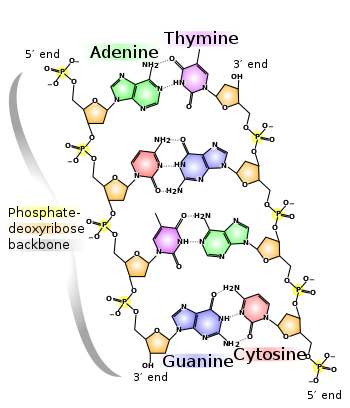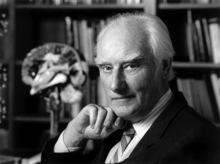Acido deoxyribonucleic

| Acido deoxyribonucleic |
|---|
| instantia de: structural class of chemical entities[*] |
| subclasse de: nucleic acids[*], biopolymer[*], biological macromolecule[*] |
| parte de: mitochondrion[*], Genoma, nucleosome[*], DNA binding[*], DNA metabolic process[*], DNA catabolic process[*], DNA biosynthetic process[*], DNA transport[*], DNA transmembrane transporter activity[*], protein-DNA-RNA complex[*], protein-DNA complex[*], DNA import into cell involved in transformation[*], catalytic activity, acting on DNA[*], nucleo |

|
|
|
| Commons: DNA |
Acido deoxyribonucleic (ADN o DNA) es un acido nucleic que contine le genetic instructiones usate in le disvelopamento e functionamento de tote organismos vive cognoscite e alicun viruses. Le role principal de ADN molecules es memorar information de termo longe. ADN es comparate frequentemente con un set de cyanotypos, o un code, proque illo contine le instructiones necessari constructer altere componentes de cellulas, como proteines e molecules ARN (Acido Ribo-Nucleic). Le segmentes de ADN que supporta isto information genetic es nominate genes, ma altere sequences de ADN ha proposito structural, o es implicate in regulatate del uso de isto information genetic.
ADN es composite, (in chimia organic) de duo longe polymeros de unitos simple nominate nucleotides.
Proprietates
[modificar | modificar fonte]
ADN es un polymer longe composito de unitos que se repeta, nominate nucleotides.[1][2] Le catena de ADN es 22 a 26 Ångströms large (2.2 to 2.6 nanometres), e uno nucleotide es 3.3 Å (0.33 nm) longe.[3]
In le organismos vive, ADN no exista como un molecule solo, ma como un par de molecules associate stricte.[4][5] Multiple nucleotide in ligamine, como in ADN, isto polymer es nominate polynucleotide.[6]
Cannellaturas
[modificar | modificar fonte]
Le helice duble es un spiral dextera. [8] [9]
Historia de recerca de DNA
[modificar | modificar fonte]
ADN esseva primero isolate de le physician Switze Friedrich Miescher 1869, quando il discoperiva un substantia microscopic in le pure de bandages chirurgic. Proque il esseva discoperite in le nucleo del cellula, il lo nominava ille "nuclein".[10]
In 1919, Phoebus Levene discoperiva le unitate basic del ADN, le nucleotide[11] In le annos 1950, Edwin Chargaff discoperiva que le amonta de thymine (T) esse casi equivilante al amonta del adenine (A); per isto, il discoperiva que le mesmo occure con guanine (G) e cytosine (C).
Un annos postea in 1952, un scientista britannic, Rosalind Franklin, studiava crystallos de DNA - specialmente, su diffraction de radios X. Con iste imagines e con communicationes private con Chargaff, James Watson e Francis Crick sugeriva que hodie esse reguardava como le prime modello correcte del structura helical duple de ADN. Con Maurice Wilkins, cuje labor supportava le hypothese de Watson e Crick, illos ganiava le Premio Nobel pro physiologia o medicina in 1962. (Franklin esseva considerate un pionero equal, ma ille moriva in 1958 per cancere ovarian, e le premio nobel non esse acccordate postumemente.)
Le final discoperatura in le analyse de DNA esseva le labor facite per Khorana, Holley e Nirenberg. Per le discoperatura per Crick que le codice genetic esseva basate in triplettos de bases, nominate "codon", Khorana, Holley, e Nirenberg discoperiva lo pro que le codones codiva; iste esseva le initio de biologia molecular.
Vide etiam
[modificar | modificar fonte]Referentias
[modificar | modificar fonte]- ↑ Alberts, Bruce; Alexander Johnson, Julian Lewis, Martin Raff, Keith Roberts, and Peter Walters (2002). Molecular Biology of the Cell; Fourth Edition. New York and London: Garland Science. ISBN 0-8153-3218-1. OCLC 145080076 48122761 57023651 69932405.
- ↑ Butler, John M. (2001). Forensic DNA Typing. Elsevier. ISBN 978-0-12-147951-0. OCLC 223032110 45406517.pp. 14–15.
- ↑ Mandelkern M, Elias J, Eden D, Crothers D (1981). "The dimensions of DNA in solution". J Mol Biol 152 (1): 153–61. doi:. PMID 7338906.
- ↑ Watson J, Crick F (1953). "Molecular structure of nucleic acids; a structure for deoxyribose nucleic acid" (PDF). Nature 171 (4356): 737–8. doi:. PMID 13054692.
- ↑ Berg J., Tymoczko J. and Stryer L. (2002) Biochemistry. W. H. Freeman and Company ISBN 0-7167-4955-6
- ↑ Abbreviations and Symbols for Nucleic Acids, Polynucleotides and their Constituents IUPAC-IUB Commission on Biochemical Nomenclature (CBN), Accessed 03 Jan 2006
- ↑ Creato ab PDB 1D65
- ↑ Wing R, Drew H, Takano T, Broka C, Tanaka S, Itakura K, Dickerson R (1980). "Crystal structure analysis of a complete turn of B-DNA". Nature 287 (5784): 755–8. doi:. PMID 7432492.
- ↑ Pabo C, Sauer R (1984). "Protein-DNA recognition". Annu Rev Biochem 53: 293–321. doi:. PMID 6236744.
- ↑ (anglese) Dahm R (2005). "Friedrich Miescher and the discovery of DNA". Dev Biol 278 (2): 274–88. doi:. PMID 15680349.
- ↑ (anglese) Levine, Phoebus A. The Structure of Yeast Nucleic Acid. Journal of Biological Chemistry: 40, 415-424.
Lectura in plus
[modificar | modificar fonte]- Clayton, Julie. (Ed.). 50 Years of DNA, Palgrave MacMillan Press, 2003. ISBN 978-1-4039-1479-8
- Judson, Horace Freeland. The Eighth Day of Creation: Makers of the Revolution in Biology, Cold Spring Harbor Laboratory Press, 1996. ISBN 978-0-87969-478-4
- Olby, Robert. The Path to The Double Helix: Discovery of DNA, first published in October 1974 by MacMillan, with foreword by Francis Crick; ISBN 978-0-486-68117-7; the definitive DNA textbook, revised in 1994, with a 9 page postscript.
- Ridley, Matt. Francis Crick: Discoverer of the Genetic Code (Eminent Lives) HarperCollins Publishers; 192 pp, ISBN 978-0-06-082333-7 2006
- Rose, Steven. The Chemistry of Life, Penguin, ISBN 978-0-14-027273-4.
- Watson, James D. and Francis H.C. Crick. A structure for Deoxyribose Nucleic Acid (PDF). Nature 171, 737–738, 25 April 1953.
- Watson, James D. DNA: The Secret of Life ISBN 978-0-375-41546-3.
- Watson, James D. The Double Helix: A Personal Account of the Discovery of the Structure of DNA (Norton Critical Editions). ISBN 978-0-393-95075-5
- Watson, James D. "Avoid boring people and other lessons from a life in science" (2007) New York: Random House. ISBN 978-0-375-41284-4
- Calladine, Chris R.; Drew, Horace R.; Luisi, Ben F. and Travers, Andrew A. Understanding DNA, Elsevier Academic Press, 2003. ISBN 978-0-12-155089-9
Ligamines externe
[modificar | modificar fonte]- The Secret Life of DNA - DNA Music compositions
- The Register of Francis Crick Personal Papers 1938 - 2007 Archived 2007-08-25 at the Wayback Machine at Mandeville Special Collections Library, Geisel Library, University of California, San Diego
- DNA Interactive This site from the Dolan DNA Learning Center included dozens of animations as well as interviews with James Watson and others (requires Adobe Flash)
- DNA from the Beginning Another DNA Learning Center site on DNA, genes, and heredity from Mendel to the human genome project.
- Double Helix 1953–2003 Archived 2007-02-13 at the Wayback Machine National Centre for Biotechnology Education
- Double helix: 50 years of DNA, Nature
- Rosalind Franklin's contributions to the study of DNA
- U.S. National DNA Day — watch videos and participate in real-time chat with top scientists
- Genetic Education Modules for Teachers — DNA from the Beginning Study Guide
- Listen to Francis Crick and James Watson talking on the BBC in 1962, 1972, and 1974
- Patrono:PDB Molecule of the Month
- Patrono:Proteopedia
- DNA under electron microscope
- Patrono:Dmoz
- DNA coiling to form chromosomes Archived 2007-07-18 at the Wayback Machine
- DISPLAR: DNA binding site prediction on protein
- Dolan DNA Learning Center
- Olby, R. (2003) "Quiet debut for the double helix" Archived 2007-02-07 at the Wayback Machine Nature 421 (January 23): 402–405.
- Basic animated guide to DNA cloning
- DNA the Double Helix Game From the official Nobel Prize web site
- DNA Lab, demonstrates how to extract DNA from wheat using readily available equipment and supplies.
| ||||||||||||||||||||||||||
